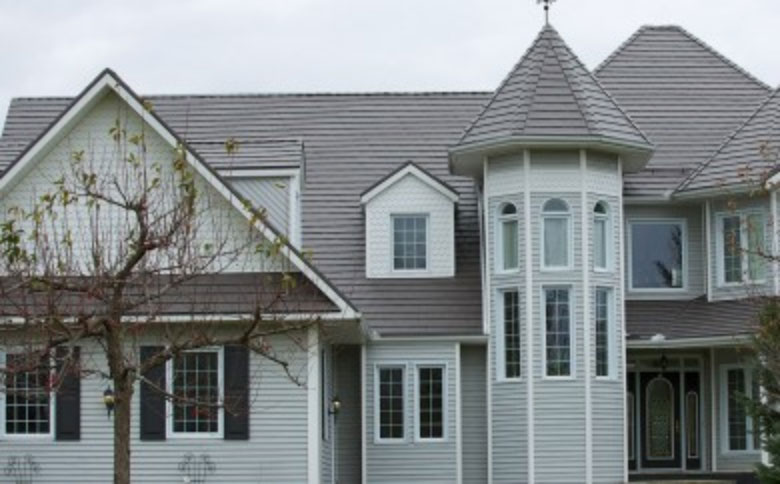Flat Roofs FAQ
What is a Flat Roof?
Any sheet of material used to cover a low-pitch roof is known as a membrane used to waterproof the entire roof, sealing out water. Materials used to cover flat roofs typically have a slight inclination to allow water to runoff into a chamber or gutter system keeping both walls and foundation dry.
Traditionally, flat roofs in the Western world make use of tar paper applied over roof decking to create a watertight barrier. The tar paper is then covered in gravel to repel the heat, UV rays, and various other weather conditions, as well as protect the roof from cracking, blistering and degradation. The roof decking is often comprised of plywood, chipboard or Oriented Strand Board, also known as Sterling board, approximately 18mm thick.
A main point of failure for this traditional type of roofing is lack of maintenance in which the gravel is displaced from the underlying tarpaper (usually due to human or weather events), thus exposing the waterproofing to weather and sun in which it breaks down over time, eventually resulting in water leakage.
Water damage of this sort can go unnoticed for long periods of time during which water will soak into the decking and insulation leading to rot which weakens the roof structure and is expensive to repair.
Thankfully for homeowners, the Forever Roof Company installs PVC membrane roofing to protect flat roofs, a more modern and reliable roofing material.
What are the major FLAT roofing systems?
About Modified bitumen membranes (MBS) (flat roof)
An MBS roofing system uses mainly polymer-modified bitumen reinforced with one or more piles of fabric such as polyester, fibreglass or a combination of both. The bitumen provides primary waterproofing protection for the membrane. The reinforcement materials add to the overall system integrity, including strength and puncture resistance.
Factory assembled MBS undergo stringent quality control testing to ensure uniform thickness and consistency throughout the membrane.
MBS are tailored to just about every type of climate and construct design.
About PVC (vinyl) membrane roofing (flat roof)
Vinyl roofs are inherently fire resistant and meet a broad range of fire ratings over common substrates. They are an energy efficient roofing option thanks to the light, reflective pigmentation.
PVC membranes are also used in waterproofing applications for roofing and are of commonplace use for green or planted roofs.
The PVC roofing membrane’s extended lifecycle in conjunction with the increased energy efficiency has made it a sustainable building product of choice for more than 60 years.
About Built-up Roofing (BUR) (flat roof)
The heart of the BUR roofing system is the roofing membrane made up of bitumen and multiple reinforced piles of roofing felt.
Bitumen roofing is the primary adhesion, or waterproofing, agent used in between roofing piles. While it arrives on site in solid form, it is then heated and applied in liquid form.
Other components of the BUR system include roof decking, vapor retarder, as well as membrane and surfacing material.
How does a flat roof get damaged and what actions need to be taken in order to maintain a flat roof?
For this reason we recommend a yearly roof inspection to be maintained for 10 to 20 years after your flat roof’s initial installation to ensure the highest quality of your roofing product is sustained.
Can a flat roof be repaired in cold temperatures?
Yes, it is possible to repair a flat roof in colder temperatures. However, there are a number of steps and precautions involved.
For example, if the felt is damaged, it is possible the roof decking may be damp. An appropriate covering will need to be applied to prevent the possibility of further damage and so that our team may strip out and dry off, as well as repair damaged decking.
Should you have an older roof or extensive damage to your current roof, repair can be costly and often the most effective solution is to simply replace the roof.
What are common Flat Roof issues?
Standing Water
If water does not drain or evaporate from your roof within 72 hours, it can begin to deteriorate the roofing material and eventually give leeway for the moisture to soak into the roof decking which will cause rot – a costly repair.
You want to ensure you have a roofing membrane with a watertight seal and that you properly maintain your roof via regular inspections, preferably on an annual basis.
Blisters
Blisters, bumps and raised areas found on your roof, occur when the roof membrane detaches from the underlying layer. This is often due to moisture seeping beneath the protective top layer of an ill-maintained roof.
Bare or Exposed Felts
Roof traffic (i.e. people), wind-blown debris and general wear and tear can damage the protective top layers of gravel and asphalt thus exposing the layers below. Without the proper protection, the exposed layers will deteriorate more quickly.
Pressure Ridges
Materials used for flat roofing will expand and contract during repeated heating and cooling cycles which may cause adjacent roofing panels to push against each other and form ridges which can crack and separate allowing moisture in.
Cracked Caulking and Seals
It is important to regularly check along roof edges and other areas for signs of dried and cracked caulking seals.
Flashing and Metalwork
Flashing and metalwork is used to seal roof protuberances such as walls and ventilation stacks. Sometimes flashing can become bent or detached.
Old Repairs
A flat roof and flat roof repairs will often last for many years. However, should you have a significantly aged roof, or there are numerous pending repairs, it is often a more effective solution to install a new roof.
Based in Bedford, we service Nova Scotia including Halifax, Dartmouth, Sydney, Truro, Lunenburg, Bridgewater, Yarmouth, Wolfville, New Glasgow, Amherst and more. We also service New Brunswick and PEI. Our courteous staff is happy to find the roofing solution that fits your needs. Call us at 902-252-5801 or drop us a message on our contact page.

Roofing HRM
The ideal Halifax Metal Roofing and Flat Roofing Contractors for residential and commercial properties.
Roofing Ideas

Areas of Service
The Forever Roof services Nova Scotia, New Brunswick and PEI with specialized metal and flat roofing products for residential and commercial projects. Some of the areas we service include:
HRM - Halifax, Dartmouth
Truro, New Glasgow
Sydney, Yarmouth
Moncton, Charlottetown
and more.

